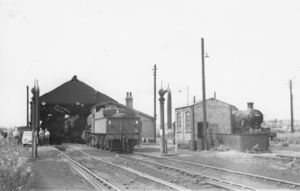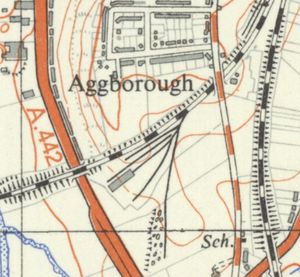Kidderminster Shed
Contents
Kidderminster Shed under GWR
Kidderminster was GWR shed number 125, code KDR, and was part of the Worcester division. The shed was situated on the south side of the line between Hoo Road Bridge and Worcester Road Bridge (on the left when travelling from Kidderminster towards Bewdley). It was built in 1932 to replace the original smaller GWR shed which was situated nearer the station. The extract from Ordnance Survey Map SO87, surveyed 1938 - 1949, published 1951, shows the later location.
A snapshot in 1943 shows the following locomotives allocated to Kidderminster (GWR unless stated)[1]:
- Cleobury Mortimer & Ditton Priors Railway CMDP Class 0-6-0PT Nos 28, 29
- Dean 2021 Class 0-6-0PT No 2153
- Churchward 4575 Class 2-6-2T Nos 4586, 4596
- Collett 5700 Class 0-6-0PT No 4625, 8718, 8727
- Collett 5101 Class 2-6-2T Nos 5110, 5112
- Churchward 4575 Class 2-6-2T Nos 5518, 5538, 5573
- Collett 8100 Class 2-6-2T No 8101
- LNER J25 Class 0-6-0 Nos 2134, 2142, 2051, 1994
Kidderminster Shed under BR
Post-War, Kidderminster had 3 different shed numbers under BR. Following nationalisation, Kidderminster initially became BR shed code 85D on 1 February 1950, as part of the group under 85 Worcester. On 10 September 1960 it became Shed 84G under 84 Wolverhampton. Finally, in 1963 responsibility for the area was transferred from the Western Region to the London Midland Region, and on 1 September 1963 it became shed 2P under 2 Rugby.
The total number of engines allocated to Kidderminster Shed post-War, albeit not all at one time, were[2]:
| Company | Designer | Locomotive class | Wheel arrangement | Number allocated |
|---|---|---|---|---|
| GWR | Churchward | 4300 Class | 2-6-0 | 22 |
| GWR | Collett | 5700 Class | 0-6-0PT | 18 |
| GWR | Collett | 5101 Class | 2-6-2T | 13 |
| GWR | Collett | 4575 Class | 2-6-2T | 5 |
| GWR | Collett | 5600 Class | 0-6-2T | 3 |
| GWR | Dean | 2021 Class | 0-6-0PT | 3 |
| GWR | Collett | 1400 Class | 0-4-2T | 2 |
| GWR | Collett | 2251 Class | 0-6-0 | 2* |
| GWR | Collett | 6100 Class | 2-6-2T | 2 |
| GWR | Churchward | 4500 Class | 2-6-2T | 1 |
| GWR | Collett | 'Grange' 6800 Class | 4-6-0 | 1 |
| GWR | Dean | 'Bulldog' 3300 Class | 4-4-0 | 1 |
| GWR | Hawksworth | 1600 Class | 0-6-0PT | 1 |
| LMS | Stanier | 3P | 2-6-2T | 1 |
| BR | Riddles | Standard Class 3 Tank | 2-6-2T | 3 |
| BR | Diesel Class 08 | 0-6-0 | 1 |
Kidderminster shed closed on 10 August 1964, with the last 8 engines being transferred to nearby Stourbridge shed (84F) 2 days earlier. The last 8 engines at Kidderminster were:
- Collett 5700 Class 0-6-0PT Nos 3601, 3607, 3619, 8718
- Collett 5101 Class 2-6-2T Nos 4147, 4153, 4173, 4175
The area formerly occupied by Kidderminster Shed is now a housing estate.
Historic maps of Kidderminster Shed
- Original GWR map showing the engine shed and associated sidings as a later amendment.
- 1927 map showing the fence line extended and a single siding in the area where the shed was to be built.
- 1938 map showing the engine shed and a further siding extending in to gravel pits to the south.
See also
References
- ↑ The Tenbury & Bewdley Railway, Keith Beddoes and William H Smith (1995)
- ↑ Kidderminster on BRDatabase.info
Further reading
- No Steam Without Fire, 'Asleft' (1978), ISBN 0950053341 Memories of life on the footplate at Wolverhampton, Kidderminster, and Newton Abbot
- When There Was Steam, Tony Barfield (1994), ISBN 1-85648-190-5 Memories of a Western Region fireman based at Kidderminster Shed



